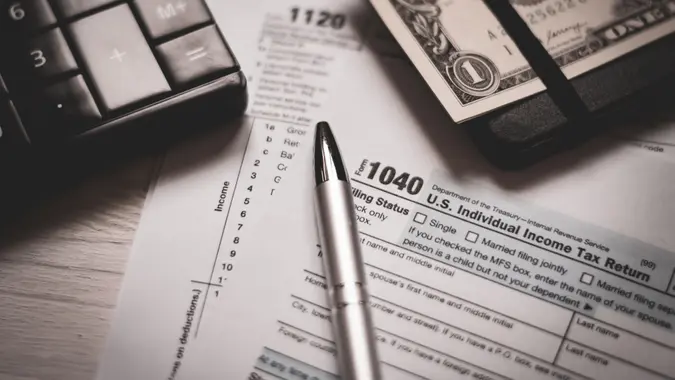How Much Is Self-Employment Tax?

Commitment to Our Readers
GOBankingRates' editorial team is committed to bringing you unbiased reviews and information. We use data-driven methodologies to evaluate financial products and services - our reviews and ratings are not influenced by advertisers. You can read more about our editorial guidelines and our products and services review methodology.

20 Years
Helping You Live Richer

Reviewed
by Experts

Trusted by
Millions of Readers
Around 10% of American workers are self-employed, running small businesses and offering services as independent contractors. With the gig economy booming, millions of people are also taking side hustles and weekend jobs to earn extra money — some are even opting to make the leap into full-time self-employment. But when you start working for yourself, you might have to pay different taxes, including the federal self-employment tax.
Check Out: What To Do If You Owe Back Taxes to the IRS
The IRS considers you self-employed when you’re in business for yourself. You may be an independent contractor or have a sole proprietorship, or you may be a partner in a partnership, including an LLC that is taxed as a partnership. Read on to learn how to calculate self-employment taxes, no matter which state you live in.
How Much Is Self-Employment Tax?
The self-employment tax is comprised of two taxes: the Social Security tax and the Medicare tax (also known as the FICA tax). As of the tax year 2023, the FICA tax rate is 15.3% — that’s 12.4% for Social Security and 2.9% for Medicare. The Medicare tax applies to all of your self-employment income, no matter how much you make.
The Social Security tax, however, is only applicable to the amount of the contribution and benefit base for the year. This amount is $160,200 for 2023, but it adjusts annually for changes in the cost of living. So, in 2023, once you earned more than $160,200, you won’t have to pay the Social Security tax on the excess portion of your earnings.
The self-employment tax is a federal tax — there are no state self-employment taxes — so your self-employment tax by state will be the same no matter where you live.
Net Self-Employment Income
Before you can calculate your self-employment or independent contractor taxes, you need to calculate your net self-employment income. Instead of having to pay self-employment taxes on every dollar you make from self-employment, you are permitted to take out self-employment tax deductions first. For example, you can use the following as a tax write-off: things like the costs of goods sold, home office expenses, advertising and vehicle expenses.
You do not pay self-employment tax on money earned through investments or the sale of property. Instead, you pay capital gains tax on this income, and the rate varies depending on the type of asset and how long you owned it.
Who Has To Pay Self-Employment Taxes?
If you earn money through a small business you own as a sole proprietor or partner, you may be required to pay self-employment taxes. Specifically, you must pay taxes when your net earnings (profits) from the small business or partnership exceed $400 for the year, and you’re expected to pay taxes on these earnings even if you currently receive benefits from Social Security or Medicare. This also applies to church employees who earn at least $108.28 and gig workers.
How To Calculate Self-Employment Tax
To calculate self-employment taxes, multiply your net self-employment income by 0.9235. Then, if the result is less than the contribution and benefit base for the year, multiply the result by the total self-employment tax rate, currently 15.3%.
Example
For example, if your net self-employment income is $50,000, multiply $50,000 by 0.9235 to get $46,175. Then, because $46,175 is less than the 2023 contribution and benefit base of $160,200, multiply $46,175 by 0.153 — 15.3% — to find that you owe $7,064.78 in self-employment taxes for the year, which would leave you with $42,935.22.
But you’ll still have to pay regular income taxes at both the federal and state level, just like you would have to pay on any other income.
On the bright side, you get to deduct an amount equal to the employer portion of the self-employment taxes — currently one-half of the total self-employment taxes — from your taxable income when you’re calculating your income taxes.
Reporting Self-Employment Income on Taxes
You report your self-employment income on your regular income tax return, but you have to file a few additional forms. First, use Schedule C to calculate your net self-employment income. Then, file Schedule SE as a self-employment tax calculator to figure out the self-employment taxes you owe.
Both your net self-employment income and your self-employment taxes will be carried over to your Form 1040 tax return. Filing your taxes correctly with self-employment income is important to avoid additional interest, penalties or an IRS audit.
What Is the Self-Employment Tax Deduction?
As a self-employed individual, you’re allowed to deduct what the IRS calls the “employer-equivalent portion of your self-employment tax,” which is half of the 15.3% tax. If you are self-employed and pay for your own health insurance, you also can deduct the cost of your insurance from your net earnings.
Making Estimated Payments
When you’re self-employed, you’ll usually need to make estimated tax payments throughout the year. You report these taxes on Form 1040-ES and can pay online, over the phone or by mail.
Underpayment of taxes can result in a penalty, and the IRS charges interest on penalties. Generally, most taxpayers will avoid this penalty in one of two ways:
- You owe less than $1,000 — after subtracting withholding/refundable credits — when you file your return.
- Your total tax payments during the year equal at least 90% of your total tax bill for the current year or 100% of the tax from the prior year.
There are also special rules for farmers and fishermen, certain household employers and certain taxpayers whose income places them in a higher IRS tax bracket. The IRS may waive your penalty if you were unable to pay after a disaster or are at least 62 years old and retired during the tax year.
You don’t have to pay estimated taxes for the current year if you meet all three of the following conditions:
- You had no tax liability for the prior year.
- You were a U.S. citizen or resident for the whole year.
- Your prior tax year covered a 12-month period.
Where’s My Refund?
Since you’re estimating your tax liability, it’s possible to overpay throughout the year. This can happen if you have more deductions or take in less income than you anticipated when you submitted your quarterly payments. In that case, you may be eligible for a tax refund. You can track the status of your refund through the IRS, and how long it takes to get a tax refund depends on when and how you submit your return.
Michael Keenan, Jordan Rosenfeld, Gabrielle Olya and Cynthia Measom contributed to the reporting for this article.
Our in-house research team and on-site financial experts work together to create content that’s accurate, impartial, and up to date. We fact-check every single statistic, quote and fact using trusted primary resources to make sure the information we provide is correct. You can learn more about GOBankingRates’ processes and standards in our editorial policy.
- IRS. 2024. "Self-employed individuals tax center."
- IRS. 2024. "Estimated taxes."
- IRS. 2024. "Instructions for Form 2210."
- IRS. 2023. "Self-Employment Tax (Social Security and Medicare Taxes)."
 Written by
Written by  Edited by
Edited by 

























